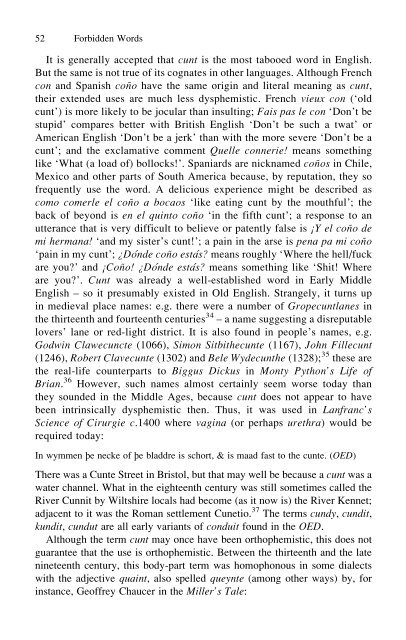Forbidden Words: Taboo and the Censoring of Language
Forbidden Words: Taboo and the Censoring of Language
Forbidden Words: Taboo and the Censoring of Language
Create successful ePaper yourself
Turn your PDF publications into a flip-book with our unique Google optimized e-Paper software.
52 <strong>Forbidden</strong> <strong>Words</strong><br />
It is generally accepted that cunt is <strong>the</strong> most tabooed word in English.<br />
But <strong>the</strong> same is not true <strong>of</strong> its cognates in o<strong>the</strong>r languages. Although French<br />
con <strong>and</strong> Spanish coño have <strong>the</strong> same origin <strong>and</strong> literal meaning as cunt,<br />
<strong>the</strong>ir extended uses are much less dysphemistic. French vieux con (‘old<br />
cunt’) is more likely to be jocular than insulting; Fais pas le con ‘Don’t be<br />
stupid’ compares better with British English ‘Don’t be such a twat’ or<br />
AmericanEnglish‘Don’tbeajerk’thanwith<strong>the</strong>moresevere‘Don’tbea<br />
cunt’; <strong>and</strong> <strong>the</strong> exclamative comment Quelle connerie! means something<br />
like ‘What (a load <strong>of</strong>) bollocks!’. Spaniards are nicknamed coños in Chile,<br />
Mexico <strong>and</strong> o<strong>the</strong>r parts <strong>of</strong> South America because, by reputation, <strong>the</strong>y so<br />
frequently use <strong>the</strong> word. A delicious experience might be described as<br />
como comerle el coño a bocaos ‘like eating cunt by <strong>the</strong> mouthful’; <strong>the</strong><br />
back <strong>of</strong> beyond is en el quinto coño ‘in <strong>the</strong> fifth cunt’; a response to an<br />
utterance that is very difficult to believe or patently false is ¡Y el coño de<br />
mi hermana! ‘<strong>and</strong> my sister’s cunt!’; a pain in <strong>the</strong> arse is pena pa mi coño<br />
‘paininmycunt’;¿Dónde coño estás? means roughly ‘Where <strong>the</strong> hell/fuck<br />
are you?’ <strong>and</strong> ¡Coño! ¿Dónde estás? means something like ‘Shit! Where<br />
are you?’. Cunt was already a well-established word in Early Middle<br />
English – so it presumably existed in Old English. Strangely, it turns up<br />
in medieval place names: e.g. <strong>the</strong>re were a number <strong>of</strong> Gropecuntlanes in<br />
<strong>the</strong> thirteenth <strong>and</strong> fourteenth centuries 34 – a name suggesting a disreputable<br />
lovers’ lane or red-light district. It is also found in people’s names, e.g.<br />
Godwin Clawecuncte (1066), Simon Sitbi<strong>the</strong>cunte (1167), John Fillecunt<br />
(1246), Robert Clavecunte (1302) <strong>and</strong> Bele Wydecun<strong>the</strong> (1328); 35 <strong>the</strong>se are<br />
<strong>the</strong> real-life counterparts to Biggus Dickus in Monty Python’s Life <strong>of</strong><br />
Brian. 36 However, such names almost certainly seem worse today than<br />
<strong>the</strong>y sounded in <strong>the</strong> Middle Ages, because cunt does not appear to have<br />
been intrinsically dysphemistic <strong>the</strong>n. Thus, it was used in Lanfranc’s<br />
Science <strong>of</strong> Cirurgie c.1400 where vagina (or perhaps urethra) would be<br />
required today:<br />
In wymmen þe necke <strong>of</strong> þe bladdre is schort, & is maad fast to <strong>the</strong> cunte. (OED)<br />
There was a Cunte Street in Bristol, but that may well be because a cunt was a<br />
water channel. What in <strong>the</strong> eighteenth century was still sometimes called <strong>the</strong><br />
River Cunnit by Wiltshire locals had become (as it now is) <strong>the</strong> River Kennet;<br />
adjacent to it was <strong>the</strong> Roman settlement Cunetio. 37 The terms cundy, cundit,<br />
kundit, cundut are all early variants <strong>of</strong> conduit found in <strong>the</strong> OED.<br />
Although <strong>the</strong> term cunt may once have been orthophemistic, this does not<br />
guarantee that <strong>the</strong> use is orthophemistic. Between <strong>the</strong> thirteenth <strong>and</strong> <strong>the</strong> late<br />
nineteenth century, this body-part term was homophonous in some dialects<br />
with <strong>the</strong> adjective quaint, also spelled queynte (among o<strong>the</strong>r ways) by, for<br />
instance, Ge<strong>of</strong>frey Chaucer in <strong>the</strong> Miller’s Tale:

















